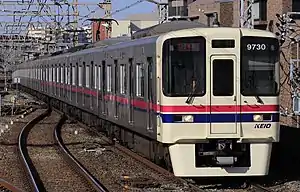Keio 9000 series
The Keio 9000 series (京王9000系) is an electric multiple unit (EMU) train type in Japan, operated by the private railway operator Keio Corporation since 2001 on the Keio Line and its branches in Tokyo and Kanagawa Prefecture.[1]
| Keio 9000 series | |
|---|---|
 10-car set 9730 in January 2019 | |
| In service | 2001– |
| Manufacturer | Nippon Sharyo, Tokyu Car Corporation |
| Constructed | 2000–2009 |
| Number built | 264 cars |
| Number in service | 264 cars |
| Formation | 8/10 cars per trainset |
| Capacity | 141 (end cars), 152 (intermediate cars) |
| Operator(s) | Keio Corporation |
| Depot(s) | Takahatafudō and Wakabadai |
| Specifications | |
| Car body construction | Stainless steel |
| Car length | 20 m (65 ft 7 in) |
| Width | 2,845 mm (9 ft 4 in) |
| Height | 4,100 mm (13 ft 5 in) |
| Doors | 4 pairs per side |
| Maximum speed | 110 km/h (68 mph) on Keio Corporation lines, 75 km/h (47 mph) on Toei Shinjuku Line |
| Traction system | Hitachi-made IGBT-VVVF |
| Power output | 170 kW (228 hp) per traction motor |
| Acceleration | 2.5 km/h/s (on Keio Corporation Line), 3.3 km/h/s (on Toei Shinjuku Line) |
| Deceleration | 4.0 km/h/s (4.5 km/h/s for emergency brake) |
| Electric system(s) | 1,500 V DC |
| Current collection method | Overhead |
| Braking system(s) | Electronically controlled pneumatic brakes with regenerative braking |
| Safety system(s) | ATC, Digital-ATC |
| Multiple working | Keio 7000 series |
| Track gauge | 1,372 mm (4 ft 6 in) Scotch Gauge |
Variants
- 9000 series: original 8-car sets (9701-9708)
- 9030 series: 10-car sets (9730-9749) for use on Toei Shinjuku Line inter-running services from 2006
Operations
9000 series
The 9000 series 8-car sets are used mainly on the Keio Line, the Takao Line, and the Sagamihara Line. These sets are mainly used on Local services during daytime. They are also used on 10-car Special Express and Rapid trains. Sets are coupled to 2-car Keio 7000 series sets to form 10-car trains.[1]
9030 series
The 9030 series 10-car sets are used primarily on inter-running services to and from the Toei Shinjuku Line.[1]
Design
The front end design is based on the design of the Keio 5000 series. The body is stainless steel.[2] Most of the sets were built at Nippon Sharyo but some sets were built at Tokyu Car Corporation. The front portion is made of steel painted ivory white.
The 9030 series sets differ from the earlier 8-car sets in having UV-cutting glass for the wide windows, eliminating the need for roller blinds, and having full-colour LED destination indicator panels.[1]
 Exterior destination panel
Exterior destination panel
Formations
As of 1 April 2013, the fleet consists of eight 8-car 9000 series sets and twenty 10-car 9030 series sets.[2]
8-car 9000 series
The 8-car 9000 series sets (9701 to 9708) are formed as shown below, with four motored (M) cars and four non-powered trailer (T) cars, and with car 1 at the western end.[2]
| Car No. | 1 | 2 | 3 | 4 | 5 | 6 | 7 | 8 |
|---|---|---|---|---|---|---|---|---|
| Designation | Tc2 | M2 | M1 | T2 | T1 | M2 | M1 | Tc1 |
| Numbering | 9750 | 9150 | 9100 | 9550 | 9500 | 9050 | 9000 | 9700 |
- Cars 3, 6, and 7 each have one single-arm pantograph.[2]
- Cars 2 and 7 have a wheelchair space.[2]
10-car 9030 series
The 10-car 9030 series sets (9730 to 9749) are formed as shown below, with five motored (M) cars and five non-powered trailer (T) cars, and with car 1 at the western end.[2]
| Car No. | 1 | 2 | 3 | 4 | 5 | 6 | 7 | 8 | 9 | 10 |
|---|---|---|---|---|---|---|---|---|---|---|
| Designation | Tc2 | M2 | M1 | T2 | T2 | M1 | T1 | M2 | M1 | Tc1 |
| Numbering | 9750 | 9250 | 9200 | 9650 | 9550 | 9100 | 9500 | 9050 | 9000 | 9700 |
- Cars 2, 3, 6, 8, and 9 each have one single-arm pantograph.[2]
- Cars 2, 5, 7, and 9 have a wheelchair space.[2]
Interior
Passenger accommodation consists of longitudinal bench seating throughout.[1] Priority seats are provided at the end of each car.[2]
 9000 series interior
9000 series interior 9000 series seating
9000 series seating Priority seats of a 9000 series set
Priority seats of a 9000 series set 9000 series LED passenger information display
9000 series LED passenger information display 9030 series interior
9030 series interior Priority seats of a 9030 series set
Priority seats of a 9030 series set 9030 series seating
9030 series seating
References
External links
| Wikimedia Commons has media related to Keio 9000 series. |
- Keio trainset details (in Japanese)
- Nippon Sharyo 9000 series information (in Japanese)
- Nippon Sharyo 9030 series information (in Japanese)